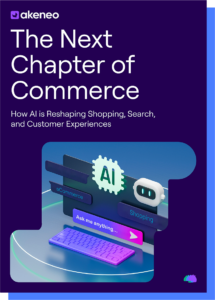The age of AI is officially here, but what does that actually mean for your business? Discover the real-world good, bad, and ugly of AI in business, from unlocking global markets and cleaning up messy product data, to the risks of bias, customer pushback, and brand sameness.

Table of Contents
Keywords
Printed books took more than 50 years to become widely available across Europe. The concept of the Internet dates back to the 1960s, yet it wasn’t until the 20th century that it permeated every-day life.
In contrast, ChatGPT reached 100 million users in just two months, with over 13 million unique users every single day.
Artificial intelligence came on the scene at unprecedented speed, and it leaves many of us struggling to make sense of what it really means for the way we live, work, and connect. Between the breathless promises of AI evangelists and the dire warnings of skeptics, it can be hard to separate hype from reality and even harder to see clearly how this powerful technology can be used effectively (and responsibly) in business.
With that in mind, let’s dive into the good, the bad, and the ugly when it comes to real-life AI use cases to give you a better understanding of AI applications and how we can all navigate this brave new world.
One of the most practical use cases for AI is cleaning and enriching product data at scale in order to ensure consistency and accuracy across even the largest catalogs. By automatically standardizing formats, categories, and naming conventions, AI helps maintain uniformity across product listings, which is essential for both internal organization and a seamless customer experience. It can detect and correct errors, merge duplicate entries, and flag missing or inconsistent information, such as harmonizing “navy” and “dark blue” or filling in missing dimensions or materials based on similar products.
Beyond cleaning, AI also enriches product data by enhancing listings with additional, customer-relevant information. This includes generating more descriptive titles and keyword-rich descriptions, suggesting tags and filters that reflect how customers actually search, and adding attributes that improve discoverability and SEO. Together, these capabilities help brands deliver a more navigable, trustworthy, and conversion-friendly shopping experience, turning a cluttered product catalog into a clear, customer-centric asset that drives better business results.
Machine learning algorithms can ingest vast amounts of customer data to produce data-driven insights into customer preferences and behavior. Consumer brands can use AI to analyze customer purchase histories and browsing patterns to offer highly personalized product recommendations and marketing content based on what similar customers have purchased in the past.
AI can also be utilized to evaluate and analyze customer reviews at scale, identifying common themes, pain points, and unexpected use cases in how customers actually interact with a product. If a significant number of reviews mention using a kitchen appliance for a purpose not originally marketed (such as using a blender to make nut butters) AI can surface this insight and communicate it back to the product and marketing teams. These teams can then update product descriptions, highlight these additional use cases, and even adjust imagery or instructions to better reflect how customers are really using the product.
While AI is no magic wand, it can act as a powerful key to unlock new global markets and sales channels by enabling brands to create tailored, localized content at scale. Entering international markets requires adapting product information to resonate with local languages, cultural expectations, and shopping behaviors. AI can help brands overcome these barriers by automatically translating product titles, descriptions, and specifications, as well as adjusting measurements, currencies, and shipping details to align with regional standards. This makes it easier for customers in different countries to understand, trust, and engage with your products, paving the way for a smoother and faster market entry.
However, it’s important to remember that AI-generated translations are not a one-and-done solution. They still require human oversight to ensure accuracy, relevance, and sensitivity to cultural nuances that machines may miss like idiomatic expressions, regional slang, or imagery that could carry unintended connotations in certain markets. That said, AI drastically reduces the time and cost associated with creating localized content, democratizing access to global audiences that may have previously been out of reach for smaller or resource-constrained brands. When used thoughtfully alongside human expertise, AI empowers companies to expand into new regions with confidence, delivering customer experiences that feel authentic and tailored, no matter where the customer is.
In the retail industry, AI-powered chatbots and virtual assistants have revolutionized customer service by enabling brands to provide immediate, around-the-clock support no matter the time zone, language, or volume of inquiries. These tools can handle thousands of conversations simultaneously, offering customers quick answers to routine questions such as order tracking, return procedures, store hours, or product availability. For global businesses, this means customers can interact in their preferred language and receive help at any time of day, creating a seamless and accessible experience that builds trust and loyalty.
However, while AI excels at handling repetitive or straightforward requests, it should not — and cannot — replace human agents when it comes to resolving complex, sensitive, or highly specific issues that require empathy, discretion, or deep product knowledge. Instead, AI is most effective as a first line of support: triaging inquiries, resolving the most common and predictable issues, and intelligently routing more challenging or nuanced cases to the appropriate human teams. This collaboration between AI and human agents not only improves operational efficiency but also ensures customers feel genuinely heard and valued when it matters most.
Utilizing AI-driven demand forecasting allows retailers to significantly improve their inventory management by making smarter, data-backed decisions about stock levels. AI algorithms can be trained on vast datasets that include historical sales data, seasonal patterns, market trends, promotional calendars, and even external factors such as weather forecasts or economic shifts. Unlike traditional forecasting methods, which often rely on static spreadsheets and broad assumptions, AI can dynamically analyze these variables in real-time, identifying patterns and anomalies that human planners might miss. For instance, it can predict a spike in demand for certain products during holidays or special events, while also accounting for factors like regional preferences or the impact of competing promotions.
By producing highly accurate predictions of future demand, AI helps retailers strike the right balance between supply and demand, effectively reducing the risk of costly overstock — which ties up capital and storage space — or understock, which leads to missed sales opportunities and dissatisfied customers. In addition, AI-driven forecasting can adapt quickly to unexpected changes, such as sudden drops in consumer confidence, supply chain disruptions, or viral trends that cause demand to surge overnight.
AI is exciting, but it’s dangerous to view this technology through rose-colored glasses. Let’s take a look at some of the risks that AI can pose to an organization (and no, it’s not robot world domination).
A strong brand identity creates an emotional connection with customers. It goes beyond mere product features and taps into the values and personality of the brand. But as AI continues to grow in popularity, with a third of all desk workers saying they utilize large language models daily at their job, we run the risk of creating a sea of similar, template-based, algorithm-generated content. Maintaining a distinctive brand identity and voice becomes an even more crucial factor as content generation becomes more automated.
Machine learning models learn from large datasets. If these training datasets contain biases or inaccuracies, the model can learn and perpetuate those biases. In the context of global brands and retailers, this can result in inaccurate, discriminatory, or unfair outcomes in various aspects of operations, from product recommendations to legal compliance and more. If the data used for training AI models is based on a customer base that skews heavily urban, you may accidentally draw insights about shopping behaviors in rural or suburban communities that aren’t accurate.
Collecting and analyzing customer data raises privacy and security concerns. Brands must implement robust cybersecurity measures to protect sensitive customer information from data breaches or cyberattacks, and be transparent with customers about the types of data they collect, why it’s collected, and how it will be used.
There’s no denying that AI is a complex technology, and implementing an AI solution into your tech stack is no small feat. You need to ensure that you have the right folks on your team to prepare your internal teams for adoption, and you need to ensure that you have the right technology in place to integrate smoothly with the new solution and seamlessly communicate product information (not to mention, you need an organized single source of truth for product information).
Some customers may perceive AI-driven interactions as impersonal and devoid of the human touch, or they can sometimes feel like they’re losing control over their interactions with others. In fact, 60% of consumers are concerned about how AI uses their personal data.
If customers perceive that a brand prioritizes automation over genuine customer interactions, they may be less likely to remain loyal and more inclined to switch to competitors who offer more personalized and human-centric services. It’s important to acknowledge this hesitation and alway consider the customer’s perspective when implementing new technology, ensuring that your technology is enhancing your team’s work and not overpowering.
Product data serves as the foundation upon which AI technology is built and trained. Just like a house’s stability relies on a strong foundation, the effectiveness of AI systems hinges on the quality of the data they are trained on. Inaccurate, incomplete, or irrelevant data can lead to unreliable AI outcomes.
But the undeniable reality is that AI is here, and it’s here to stay; so the question becomes, how do brands and retailers embrace and implement this technology without losing the trust they’ve built with consumers?
If you’re ready to explore how AI and other emerging technologies are driving the next chapter of commerce (and how your business can stay ahead), we invite you to download our whitepaper, The Next Chapter of Commerce. Packed with insights, strategies, and real-world examples, it’s your guide to navigating the future with confidence and embracing the benefits of AI while minimizing the risks.
Discover how AI is transforming shopping, search, and product experiences, and why clean, structured data is the key to staying competitive in the next era of commerce.
